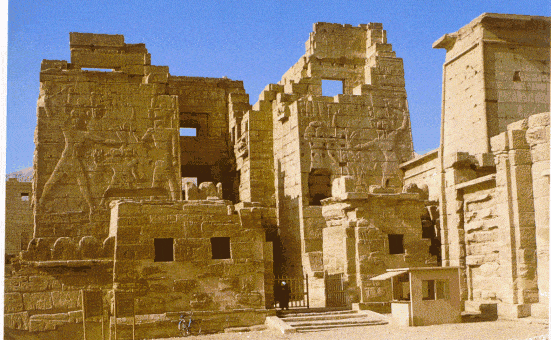
The office of the “Divine Adoratrices of Amun”, also called “God’s wives of Amun” dates back at
least to the New Kingdom, when it tended to be held by a queen not necessarily resident in Thebes.
During the Third Intermediate Period, the office developed into the main focus of the practice of the
cult of Amun in Thebes. The office was not hereditary, as the occupants of the office were not
allowed to marry, but rather adoptive. At some point in her life the Adoratrice would adopt a young
woman, who would hold the office as junior partner, and who would become the senior Divine
Adoratrice on the older woman’s death. A number of these women built chapels for themselves near
to the High Gate at Medinet Habu during the 25th and 26th dynasties. Above the doors of the
chapels, texts appeal to visitors to pray for the princesses and make offerings to their souls.
The Divine Adoratrice Amenerdis I, her name in cartouche
before her, depicted on the walls of her burial chapel –
the best preserved of the Saite chapels within the
Medinet Habu complex
In the centre of the four-columned hall of the
chapel of Amenirdis I (25th dynasty) is this
black granite offering table decorated with
loaves of bread, jugs of wine, and cooked fowl.
| The Chapels of the Divine Adoratrices at Medinet Habu |
The photography by Lenka and Andy Peacock
Sources:
1. Strudwick, Nigel: The British Museum masterpieces of ancient Egypt. London : The British Museum Press, 2006.
2. Taylor, John H.: Death and afterlife in ancient Egypt
London : British Museum Press, 2001.
3. Shaw, Ian, Nicholson, Paul: British Museum dictionary of ancient Egypt
London: British Museum Press, 1995.
4. Strudwick, Nigel and Helen: Thebes in Egypt : a guide to the tombs and temples of ancient Luxor
London : British Museum Press, 1999.
5. Weeks, Kent R.: The treasures of Luxor and the Valley of the Kings
Cercelli : White Star Publishers, 2005
6. The British Museum’s gallery labels
7. The British Museum’s web site
British Museum EA 32
26th dynasty, about 530 BC
From Thebes. Found by the French expedition in the rock tomb above Deir el-Medina in 1832.
Ankhnesneferibre was the last “God’s Wife of Amun” or “divine adoratrice of Amun” before the Persian
conquest of 525 BC. She was a daughter of Psamtek II (595-589 BC). Although the sarcophagus was
found in so called “tombs of Saite princesses” at Deir el-Medina, Ankhnesneferibre and several other
women with the same title had tomb chapels at Medinet Habu, in front of the Ramesses III’s temple.
The sarcophagus was reused in Roman times by Amenhotep Pamontu, a priest of the late Ptolemaic or
early Roman period, whose brother Montuzaf was buried elsewhere in the necropolis. Amenhotep Pamontu
added the inscription around the upper edge of the sarcophagus base. He also added his own name in the
princess’s cartouches and changed the pronouns in the text. The lid shows the princess clasping the royal
crook and flail, symbolising her powerful position in Thebes. The office of divine adoratrice became a focus
of power and influence during the Late period.
The inscriptions represent a variety of religious texts. They include parts from the Pyramid Texts, the
Book of the Dead, several mythological texts, recitations from funeral rites, magical texts, a hymn to
the sun, and hourly rituals for a vigil over the deceased, as well as offering formulas. The combination is
unparalleled elsewhere.
Length : 259 cm
